Contents
When you first lay eyes on a motorcycle, you immediately notice the mirrors, handlebars, and chassis. Strain harder and your brain registers the headlight and chassis fall within your field of vision. Maybe the fenders too. If you’ve also noticed, these are the parts you tend to repair first.
The brain gives more credence to objects that are more visible. Unfortunately, tires, being hidden beneath the motorcycle chassis, get the short end of the stick. Many riders don’t even know about the condition of their motorcycle tires until they feel significantly different riding on. Which can be dangerous.
Motorcycle tires have a long history, and they’ve gone through steady progress in the improvement of their attributes ever since their inception. The earliest wheels were spoked, used inner tubes to hold air, and were made of either metal and/or wood. But today, manufacturers spend an immense amount of time perusing every detail of the tire of a motorcycle before putting it on for sale. There’s a lot of thought that goes into the making of motorcycle parts- and tires are no exception.
This article will tell you everything about the difference between the front and rear motorcycle tire, what makes them different, and why they’re different.
Can a rear motorcycle tire be used on the front?
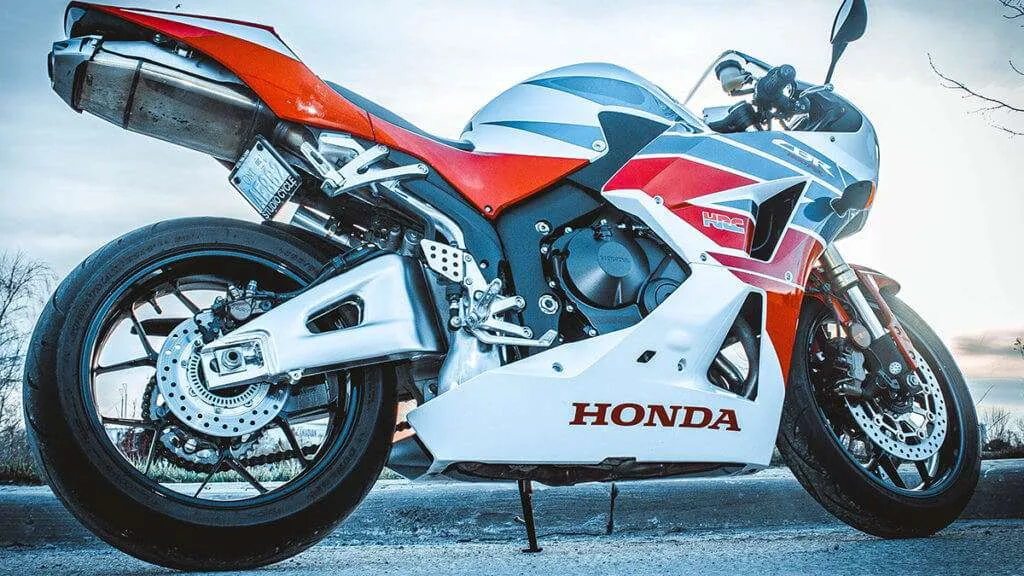
Question: Can I use the rear and front tires of my motorcycle interchangeably?
Short answer: No.
Question: Can I use the rear and front tires of my motorcycle interchangeably, and can I also have an answer longer than two letters?
Short answer: Yes.
(That was three letters.)
Long answer: The reason you can’t use rear and front tires in motorcycles interchangeably boils down to the basic fact that the tires have different functions.
The front wheels are more narrow and have a larger circumference to help with movement and steering.
The rear wheels are wider and have a smaller circumference to help with traction and control.
Difference In Function Of Front And Rear Motorcycle Tires
Size and width aren’t the only features that distinguish between the front and rear tires. Factors such as the tire treads and the direction of rotation of the wheel matter too (which we’ll cover later). But there are many factors as to why each wheel is made the way it’s made, and as we mentioned above, it all boils down to their basic functions:
Function of rear motorcycle tires
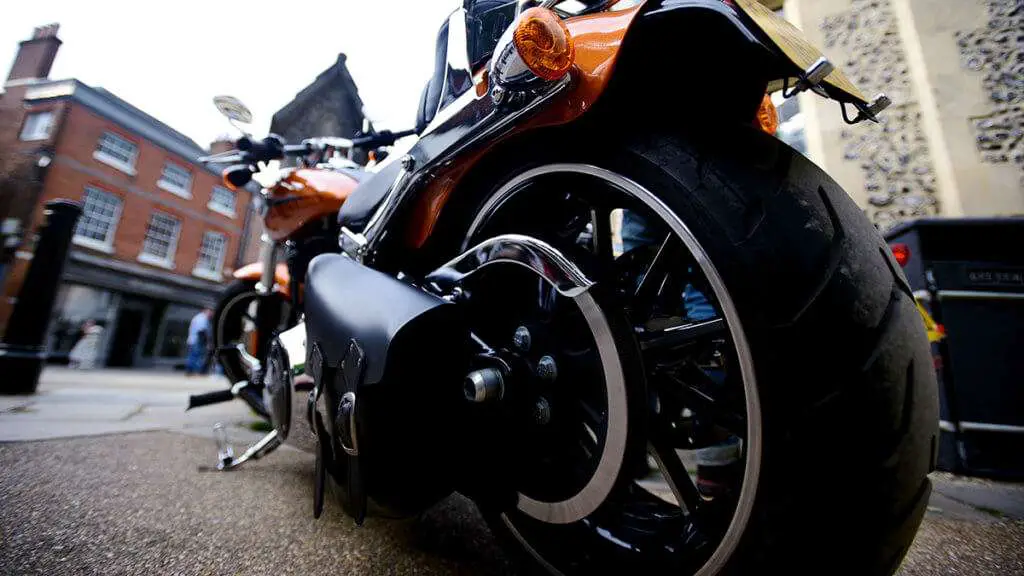
- Power: The flatter profile of a rear tire was curated to help the acceleration and stability of your bike.
- Weight: The rear tire carries more than half the weight of the bike, being right under the engine.
- Lean: Since the rear tire does not turn, its lean angle is subject to the lean of the motorcycle as a whole. Which requires a sturdier tire with a flatter profile to mitigate.
Function of front motorcycle tires
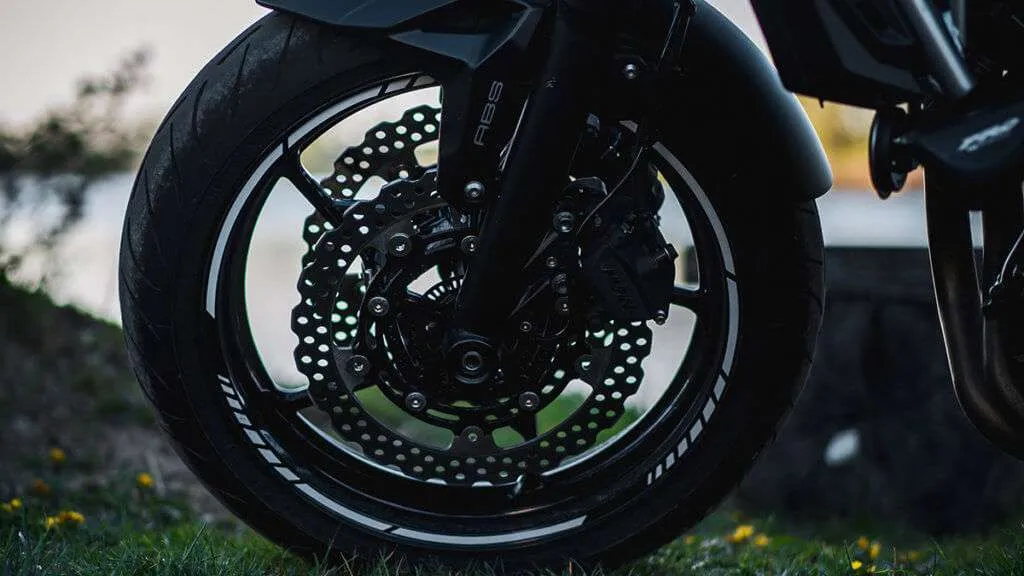
- Braking: The front tire provides up to 80% of the braking power of the motorcycle.
- Maneuvering: Front tires are manually controlled by you (through the handlebars). This is why they’re more narrow and have a larger diameter than rear tires. This is to help you maneuver easier.
Why the tire width and diameter of front motorcycle tires are different from rear motorcycle tires
As we briefly covered above, the main factors that determine the width and diameter of a motorcycle tire are:
- The weight distribution of the bike: This is why the rear wheel carries most of the weight.
- Traction for the wheel from the engine power: This is why the rear tire due to the proximity to the engine has a greater contact patch for better traction.
- How maneuverable it is: This is why the front wheel is kept as light as possible, to reduce the gyroscopic effect (The tendency of the rotating body to maintain a steady direction of its axis of rotation).
Besides these conceptual factors, thinner tires have a lower tendency to follow patterns on uneven road surfaces- which again taps into the ease of maneuverability.
But rear tires with an increased tire width, on the other hand, have greater surface contact with the road. Grooves on asphalt roads cause a certain offset from the tire centerline. The force of impact that is converted into the momentum of the motorcycle depends on the surface area of the tire. Which, as you can tell from reading so far, is dissipated better by the wider rear tires for better stability.
For the same reason, the side slope angle required by the motorcycle when cornering is directly proportional to the tire width. More surface contact suits the rear tire for stability and traction when leaning into a corner. On the contrary, lesser surface contact suits the front tire for navigating these corners.
The Risks That Come With Replacing Motorcycle Stock Tires With Tires You Bought On Your Own
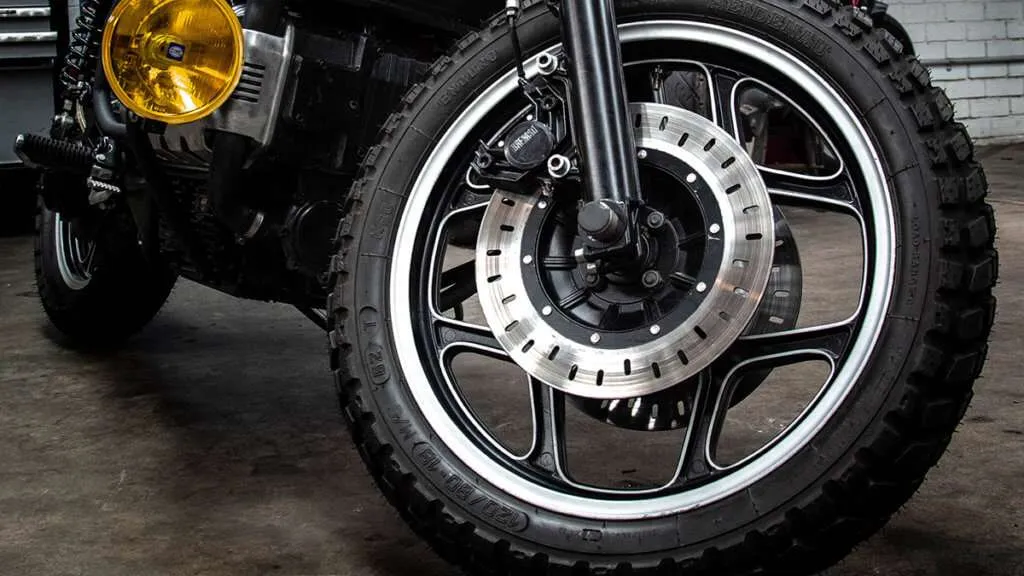
As you can probably tell from the section above, replacing motorcycle tires without doing the requisite homework isn’t a very good idea. This is because:
- Buying tires that are larger than what the motorcycle originally had can rub on the frame and wiring. This will inadvertently cause damage to your motorcycle.
- Buying tires smaller than what the motorcycle originally had is a recipe for disaster. Unable to handle the weight and maneuvering of the motorcycle, the tires are prone to succumb to the pressure and burst.
Tire Terminology To Simplify Tire Anatomy
As we mentioned in the beginning, there’s too much information about motorcycle tires for the unaccustomed to memorize. Which is why we’re not going to go too in-depth. And also why we wrote this section to make it easier for you.
Because knowing the terminology of different parts of motorcycle tires won’t just give you an idea of the general anatomy of a motorcycle tire. You’ll also have a much more holistic view of articles like these by expending relatively little effort to memorize the details. Even if the terms themselves aren’t directly mentioned.
Terms like:
Tire Tread
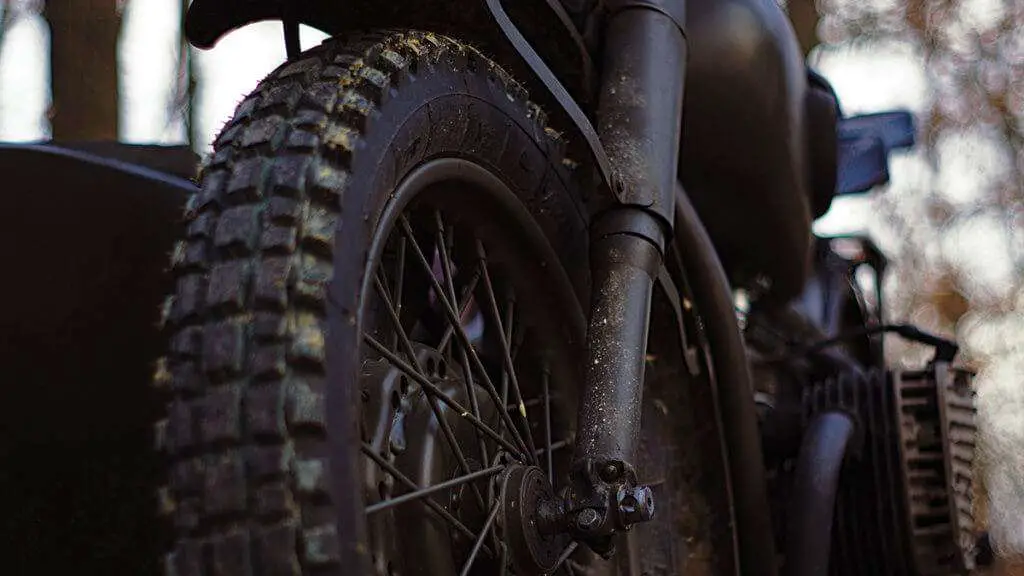
Notice those patterns of grooves on the surface of every tire? Those weren’t designed on tires to look cool (even though they do). They were designed in various ways to designate the space in between, the “tread”, in various ways.
And the tread is by far the most important part of the wheel when evaluating its health and longevity. So important in fact, that an entire segment of this article is dedicated to tire treads alone. Which is why we’re keeping this segment short:
The “tread” is the portion of the tire that makes contact with the road. (The part that is not the cool-looking grooves.)
Bead
The edge of a tire that sits on the wheel. Has a snug fit to the wheel to prevent the wheel from slipping while the motorcycle is in motion and the tire rotates.
Carcass
The “body” of the tire, which comprises two types:
- Bodies with bias-ply belts: Which are typically cords made of fiber
- Bodies with radial belts: Which have steel reinforcing belts running from bead to bead
Sidewall
The part of the tire that bridges between the tread and bead. Composed mostly of rubber but reinforced with fabric or steel cords. Responsible for much of the tire’s handling and load transfer characteristics
Shoulder
The part of the tire at the edge of the tread making the transition to the sidewall.
Plies
Layers of inextensible cords embedded in the rubber to keep its shape. This is to prevent the rubber from stretching in response to the internal pressure sustained by the tire.
When To Change The Tires On Your Motorcycle
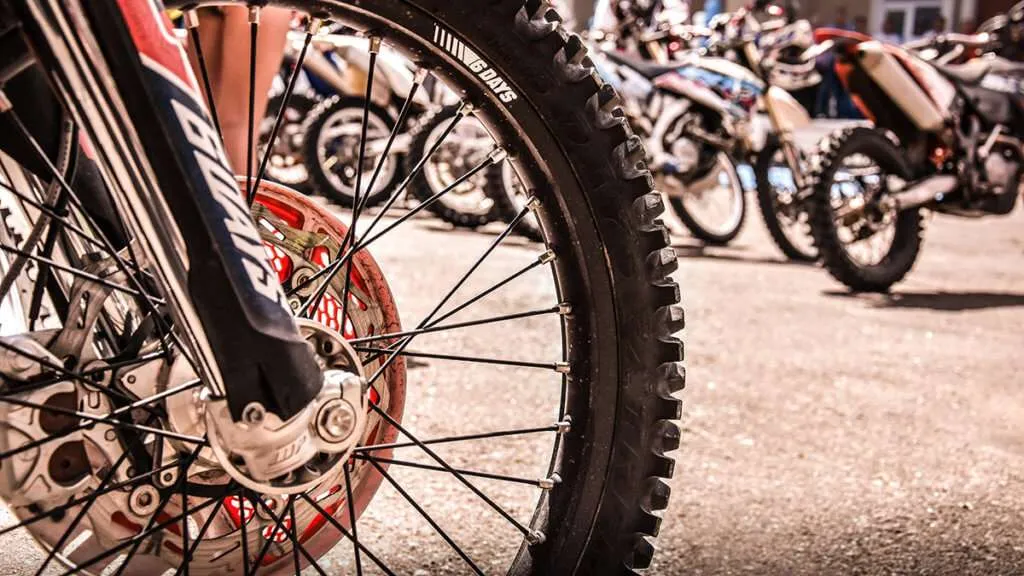
It’s not unusual for riders who go on long tours regularly to replace the front tire for every second time they change the rear tire. This is because the rear tire takes up much more than half the bike’s weight (also the reason for their larger width) and transmits the entirety of the engine power to the road.
That being said, the 2-rears-for-every-front is not a hard and fast rule. Sometimes, you can figure out that something’s wrong with your tires through intuition alone. Warning signs such as vibration, handling instability, rubbing, or tire noise while you ride are all causes for concern that warrant check-ups.
And while you perform check-ups, you need to keep the following in mind:
i) Tread depth
Generally speaking, you should replace the tires when the tread depth goes beyond 1/16”.
Most motorcycle tires come with built-in tread wear indicators. These indicators are set at 1/32nd of an inch (0.8 millimeters)- when the wire is worn down to a groove depth that is even less, that’s a sign that it needs to be replaced. If your tire doesn’t have an indicator, a small coin like a nickel or penny is a good way to gauge the depth.
The tread depth is an indicator of how thin the tire is. As you probably know, tires that have become thin over time are prone to much more damage from sharp objects. An exposed tire cord or torn fabric is very dangerous to ride with.
ii) The wheel rims
Bent rims are a recipe for poor handling and a decreased fuel economy. If the tires are tubeless, they’re also going to cause gradual air loss over time. Which is why they should be replaced as soon as you detect them.
iii) Uneven wear
As the terrain you ride on won’t be constantly uniform, different parts on the tire are going to sustain different amounts of wear.
The most common type of wear is the one on the centerline of the tire due to continuous straight-line highway driving. Due to which the tread depth indicators mentioned above often show up on the centerline before they do on the edges. Be on the lookout for any scalping and cupping as well.
iv) Age of The Tire
We recommend not using a tire for more than five years, even if it isn’t worn out or has any obvious cuts. Tires harden up over time as the oils in the rubber evaporate. And harder tires have a higher probability of sliding and slipping.
Your tire has a four-digit number representing the date of manufacture- the first two digits represent the week number while the last two represent the year of manufacture.
Front and rear tires have different tread patterns
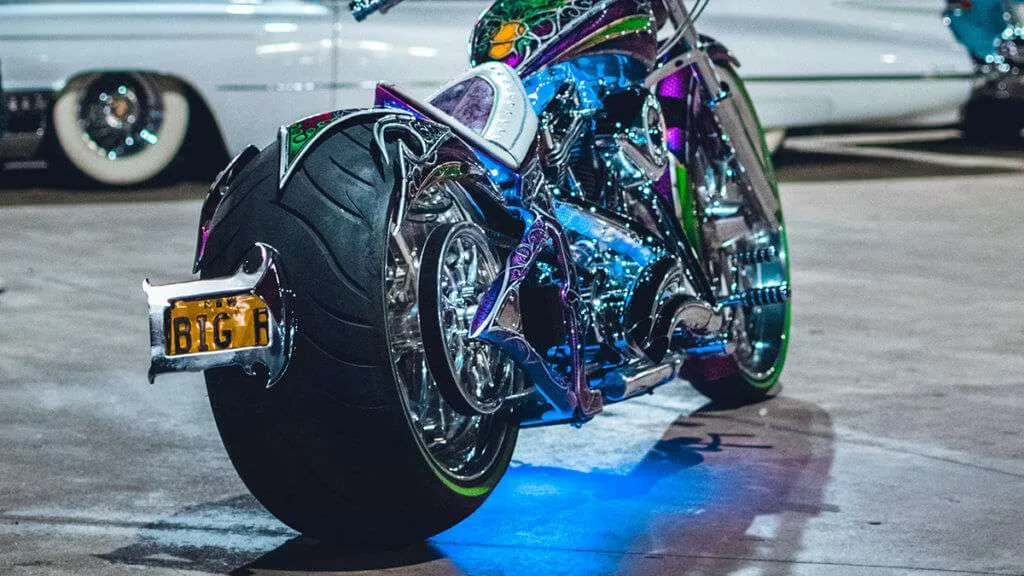
Another reason why you can’t use front and rear tires interchangeably is that their directions of rotation are different. And this is because of the difference in tread patterns.
Now, front and rear motorcycle tires don’t just have different tread patterns, they have different tread pattern directions as well.
You’ve probably noticed this play out when you ride during/ right after it rains. Even though both wheels have the same angular velocity (i.e. rotate at the same speed), they direct the water on the ground toward different directions. The rear tire generally pushes water to the side. While the front tire pushes water towards the center of the motorcycle.
This is because motorcycle tires come with treads that orient toward a specific direction. And these directions depend on the forces experienced by the tire- and as mentioned earlier in the article, the front and rear tires of a motorcycle experience different forces.
The tread on the rear wheel was created in a pattern to repel water. This, in turn, keeps more traction on the road when the road is wet and prevents aquaplaning.

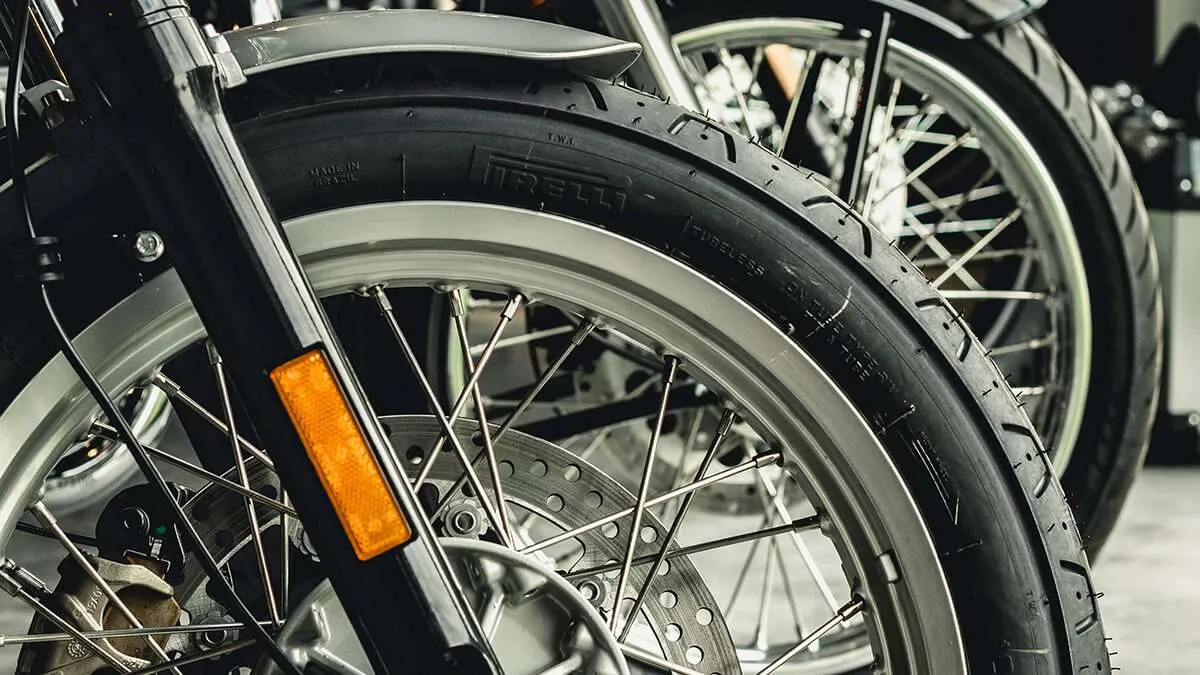
 How to Choose Motorcycle Wheel Chocks – Our 5 Best Picks
How to Choose Motorcycle Wheel Chocks – Our 5 Best Picks 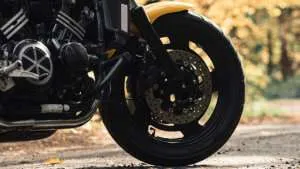 3 Motorcycle TPMS Options For Longer, Better Rides
3 Motorcycle TPMS Options For Longer, Better Rides 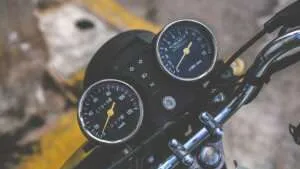 Are Speedometers Required on Motorcycles?
Are Speedometers Required on Motorcycles? 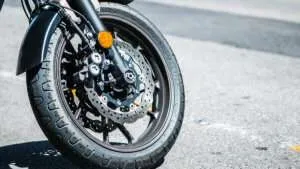 Can You Patch a Motorcycle Tire? It’s better to Check These First
Can You Patch a Motorcycle Tire? It’s better to Check These First 